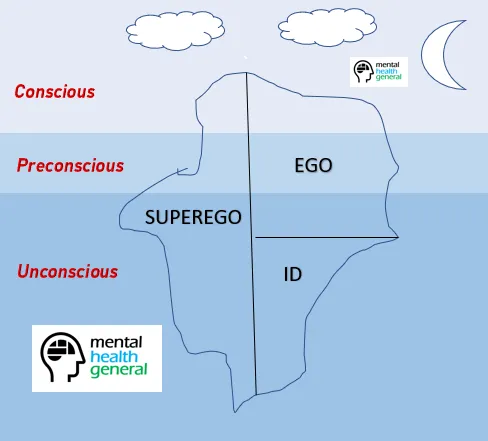
Sigmund Freud was responsible for some of the most well-known psychological theories – of which many continue to impact modern-day psychology. Perhaps one of Freud’s most well-known contributions came in his theory on personality.
Freud’s theory of personality featured distinct areas – namely the “ego”, the “superego”, and the “Id”. In this article, we will review Freud’s theory of the Id. For information on how the different parts of the personality compare, you can see our overview article here.
Embed from Getty ImagesFreud’s Theory of Personality
Freud’s theory of personality is based on the idea that there are three components of personality – the id, the Ego, and the Superego. They link to what Freud calls the conscious, unconscious and preconscious mind.
Freud believes that the id is the part of our personality that aims to satisfy basic needs; the superego is “the parent in our head” that looks out for our best interests; and the ego is the part of our personality that balances out the urges from the id and the superego.
Freud likened personality to an iceberg; an individual can only see a small piece of personality (i.e. the tip of the iceberg above the water), with most hidden away from view (like the iceberg).
The tip of the iceberg refers to what a person is aware of, and the forefront of the mind – as they are aware, it is considered to be the “conscious mind“. But under the water, there is an “unconscious mind” – where hidden thoughts, memories, feelings and desires are present [1].

What is the id?
The id resides in the unconscious mind. Freud suggested that the id is the personality component which controls an individual’s urges, needs and desires – with the energy in the id working to satisfy these areas.
The id aims for pleasure – with immediate gratification needed to complete this. The id of a person will drive an individual to reach these pleasurable outcomes as quickly as possible.
This can work two ways however – the id may compel an individual to avoid something – such as illicit substances. There are therefore both positives and negatives attached to it.
When does the id develop?
Interestingly, Freud suggested that the id was the only part of personality that an individual is born with. The id resides in the unconscious mind – the part of a mind that a human isn’t aware of; it may include past memories, hidden desires and repressed thoughts.
As the id is present from birth, Freud believed that this was the main force behind a personality developing. It aims to fulfil the basic needs of a person. Most of these basic needs are focused on survival.
As a person ages, the need to satisfy urges continues. But by then, the id contains the life and death instincts – helping an individual to regulate their behaviour. Freud believed that the id continues to do everything in its power to satisfy the urges, irrespective of laws or social norms.
But it is controlled by other elements of the personality and mind. The ego (part of the mind which puts thoughts into a coherent argument) helps to regulate behaviour, with the id pulling one way, and the superego (“the parent of the head”, which tries to mitigate the impulsive behaviour of the id) pulling the other way. As mentioned, eventually the ego comes to a sensible decision, based on the course of action.
The link to mental health
According to Freud, mental disturbance arises when the ego isn’t able to maintain its control of the id and the superego. Perhaps their impulses become too strong, and they engage in harmful behaviour.
Freud’s theory states that this disparity between the three states is often causes by trauma from early childhood. But this isn’t something that many of Freud’s fellow psychologists have agreed with.
In modern-day mental health, these ideas are taken into account in psychoanalysis-inspired talking therapies like Psychoanalytical Psychotherapy and Psychodynamic Psychotherapy.
Summary
Freud’s theory of personality has been questioned by many. However, Freud crafted his theories based on years of research and his own personal experiences. His teachings have inspired many to follow his theories.
You can see our corresponding articles on the other two parts of the mind in line with Freud’s theory – the Ego and the Superego. Moreover, you can see more about Freud by seeing our list of articles about Freud here.
See Also
- Overview of Sigmund Freud and His Theories
- Freud’s Theory of the Id, the Ego and the Superego
- Freud’s Theory of the Id and Mental Health
- Freud’s Theory of the Ego and Mental Health
- Freud’s Theory of the Superego and Mental Health
- Explaining The Two Parts of the Superego According to Freud
Disclaimer
This website should be used purely for informational purposes, and does not intend to, nor should it ever, be used as a replacement for professional medical advice.
We strive to keep all of our pages updated, and ensure that our website is full of factual and in-depth information. However, we encourage you to browse this website with care.
As a reminder, this website and all content within it cannot and should not replace the advice of a trained medical professional. You can read our full disclaimer at this link.
Helplines
If you are struggling with your mental health, help is available. With the right support and treatment, you can make a recovery. For information on helplines, or if you are in a state of crisis, please visit our crisis page by clicking on the relevant link for your geographical location (United Kingdom), (United States), (International). You can also see how to get mental health treatment and the process involved by clicking this link.
References
[1] Freud, S., & Hall, G. S. (1920). A general introduction to psychoanalysis. Boni and Liveright: New York.

































